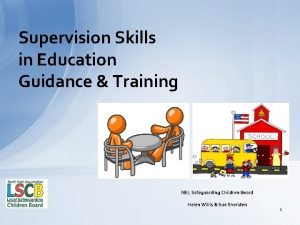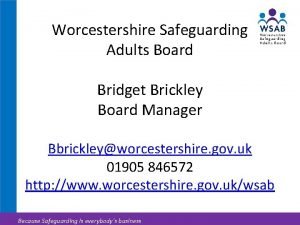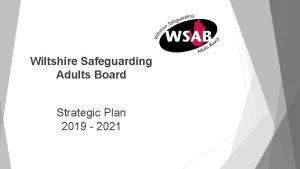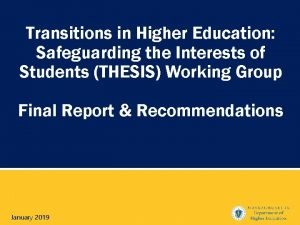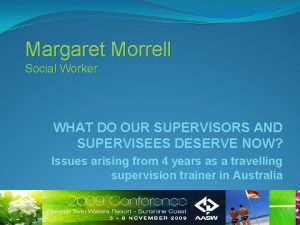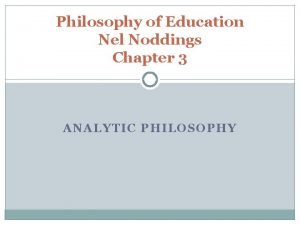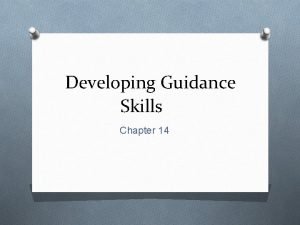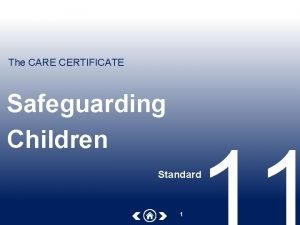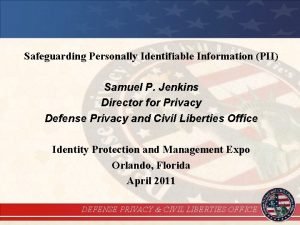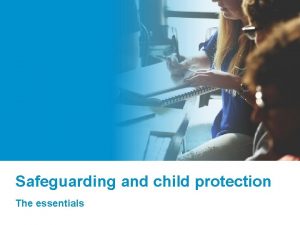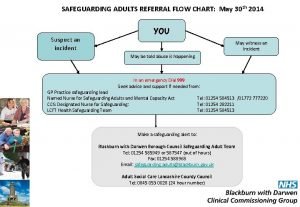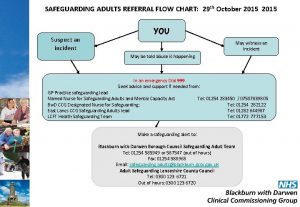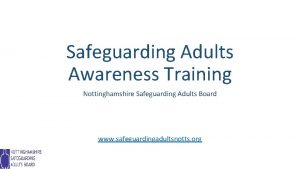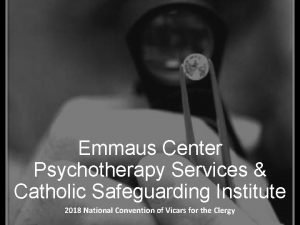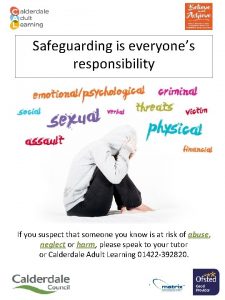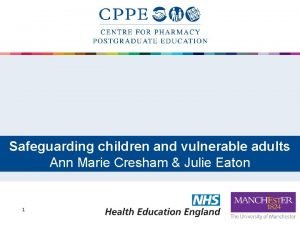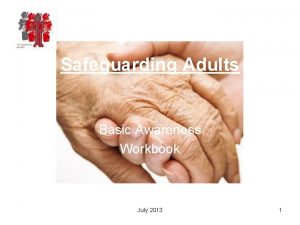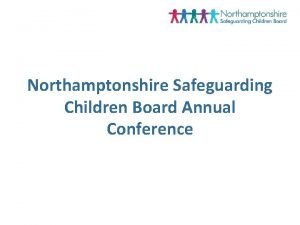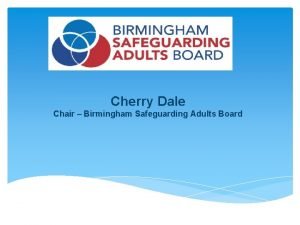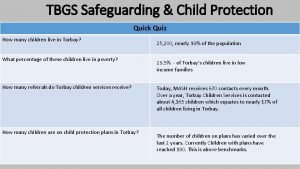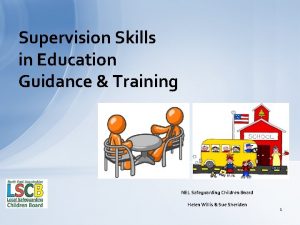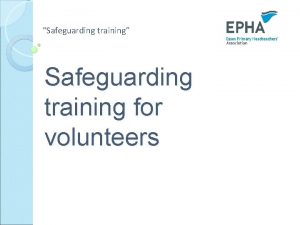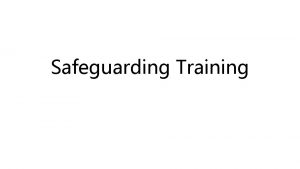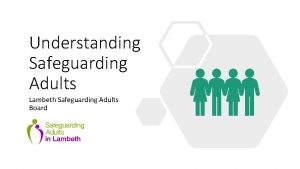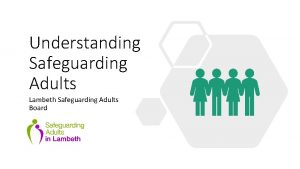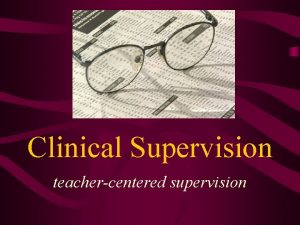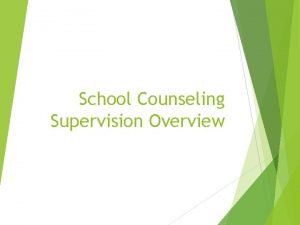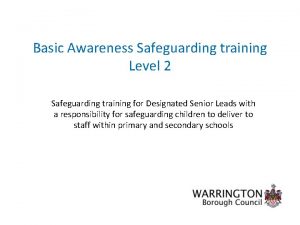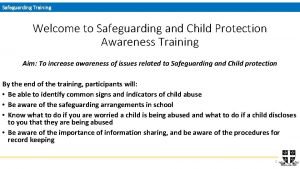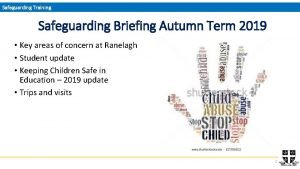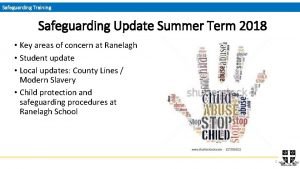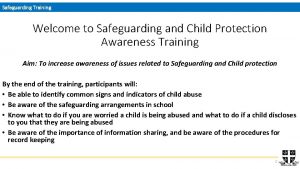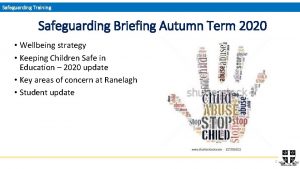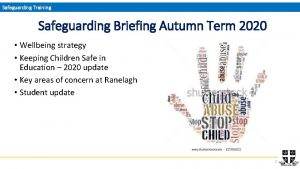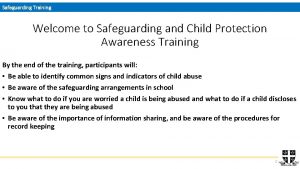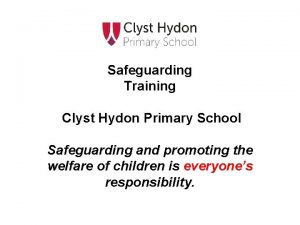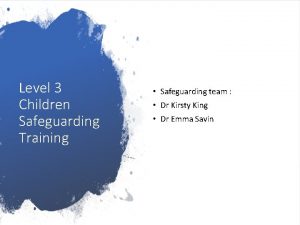Supervision Skills in Education Guidance Training NEL Safeguarding






























- Slides: 30

Supervision Skills in Education Guidance & Training NEL Safeguarding Children Board Helen Willis & Sue Sheriden 1

Purpose T 0 support Head Teachers, Deputies & CP co-0 rdinators to establish and provide supervision and guidance to staff • • Provide Education Supervision Guidance and training Be clear on the key functions of supervision Understand role of the supervisor and role of the supervisee Use of the supervision contract and agreement NEL Safeguarding Children Board 2

Learning Outcomes • To evaluate the benefits of supervision for: Ø Staff members and supervisees Ø The organisation and its partners in other services Ø Children and their families and to recognise: Ø Some of the barriers that can prevent effective supervision Ø How supervision supports staff to assess risk, analyse vulnerability concerns and make referrals NEL Safeguarding Children Board 3

What is Supervision? Safeguarding Supervision is an accountable process that supports, assures and develops the knowledge, skills and values of individuals, groups or teams. Its purpose is to improve the quality of work to achieve agreed outcomes and promote safe practice. ‘Supervision should give workers the opportunity to think differently and creatively about their work’ Munro(2011) NEL Safeguarding Children Board 4

Individual Expectations : Exercise NEL Safeguarding Children Board 5

Why do we need supervision? • • To maintain & develop the quality and safety of practice Staff want to do a good job – no one wants to be ineffective Staff can learn, change & develop if doing so makes sense Performance can be improved if areas for development are identified and worked on together • Professional advice and direction is key to analysis and decision-making in safeguarding • SCRs learning identifies heightened risk and danger when supervision and management oversight is absent NEL Safeguarding Children Board 6

The Four Stakeholders Children & Families Partners Supervision Workers Organisation NEL Safeguarding Children Board 7

The Four Core Functions (Adapted from Proctor 2001, Morrison 2005 and Wallback & Wonnacott 2016) Managerial Educational Developing the practitioner’s skills and competence Relating to standards & Performance and safe outcomes for children Mediation Establishes roles and dialogue between staff, supervisor, organisation and partners NEL Safeguarding Children Board Supportive of the practitioner in stressful and sometimes dangerous situations 8

The Supervision Contract (Agreement) • Supervision should be underpinned by a ‘contract’ or supervision agreement • Contracts should be mutually agreed and include: – – – Frequency – E. g. minimum half-termly (6 weeks) Timing and duration of sessions – Minimum of an hour Venue and environment Arrangements to cancel or postpone sessions Expectations: including confidentiality and how to resolve conflict or disagreement – Boundaries – what’s expected to happen and when ? ? – How practice issues will be managed NEL Safeguarding Children Board 9

Confidentiality Agreements Personal matters will remain confidential unless… • They impact on the safety and protection of a child; a vulnerable adult or others • To protect the supervisee’s health or wellbeing • They impact on the reputation of the school or organisation • They are competency or conduct issues that are so serious they will affect the employee status • An offence or criminal matter is involved NEL Safeguarding Children Board 10

When Conflict or Disagreement arises… Supervisors and Supervisees won’t always agree & sometimes our views and opinions conflict with other professionals. When this happens always be prepared to: • Try to resolve matters amicably in supervision sessions first, looking at why the conflict has arisen • Know to whom and how the matter will be escalated if it’s between supervisor and supervisee • Know how to use the LSCB escalation process if the conflict is between school and another agency NEL Safeguarding Children Board 11

The Supervision Record Supervision records should always be used and include: • • • Date, venue, duration Progress on actions from last supervision Topics & cases discussed What is working well, what we are worried about Welfare/ safeguarding children concerns Timeframes for actions and interventions Agreed actions/ outcomes /decisions & decision makers Any matters to be escalated or referred on to other agencies Signed and dated by supervisor and staff member NEL Safeguarding Children Board 12

Structures for Supervision Formal Planned Meeting Ad hoc Unplanned discussion Agenda Agreed Agenda agreed on the spot Often as a result of a problem arising Planned Feedback / Constructive criticism given while working Informal Given while the worker is engaged in a service delivery task Agreed in advance with predetermined objectives Unplanned activity because of need and circumstances NEL Safeguarding Children Board 13

The Supervisor needs to be. . . A competent practitioner & able to show they are: • Self aware – and responsive to supervisee • Reliable and trustworthy • Motivated and able to exercise ‘People Skills’ • Empathetic and able to challenge constructively • Committed to the supervision process NEL Safeguarding Children Board 14

The Supervisee: • May also be a supervisor, so must accept the change in roles • Acknowledges the importance of the supervision process • Is prepared for supervision • Participates in setting the agenda and takes responsibility for their part in decision-making • Must be willing to explore their own working practices in an open and honest manner • Deliver constructive feedback to the supervisor NEL Safeguarding Children Board 15

Roles & Responsibilities Both Supervisor & Supervisee need to: • Understand their own & each’s roles & responsibilities • Practice restoratively & promote effective supervision • Be respectful and effective in the relationships • Address the emotional aspects of safeguarding children NEL Safeguarding Children Board 16

Qualities of a Learning Environment • Open & honest communications • Recognition of each other’s perspective • Personal experience is recognised and valued as a resource for further learning, and both parties are able to relate learning to their own experience • Individual learning styles are taken into account • Success is celebrated and strengths acknowledged • Stimulation - the motivation to learn is intrinsic • The mind-set & environment reduce anxiety • Confidentiality & management of information frameworks are clear, • Supervision is recorded and supervisee can reflect on new ideas. NEL Safeguarding Children Board 17

Supervision Outcome Cycle More open in supervision Worker rewarded and confident Effective supervision, clear, safe and enabling. Supervisor has accurate assessment of the worker’s competence. Supervision Outcome Cycle Better shared plans Clearer evidence based assessment. Worker/user clear on next steps and mutual expectations NEL Safeguarding Children Board Better practice, Better support for practitioners, Better & Safer outcomes for Children, Parents & Organisations Worker clear and confident in role and task Child/Family confident in the worker Increased clarity, trust openness and sharing of information. Reduced anxiety and stronger partnership. 18

Key Features of Working with Children & Families for staff in educational settings • • • Emotional nature & impact of the work Cultural differences, acknowledging diversity Assessing child’s educational needs & impact Assessing parenting capacity issues/ impact on child Sometimes resistant, non-engagement by parents Recording worries, raising with designated CP Lead Signposting, i. e. speech language, behaviour Contributing to Early help Assessments Multi disciplinary & multi agency aspects NEL Safeguarding Children Board 19

Child Concern Model NEL Safeguarding Children Board 20

The supervisor needs to help the worker identify what they are worried about? Question appropriately: ØSigns of Safety (and 7 W’s ) • What is working well? • What are we worried about? • Why do we need to be involved now? • What are the Complicating Factors? • Who might be able to support this family? • What needs to happen? • What else do we need to know? NEL Safeguarding Children Board 21

Child welfare/ Safeguarding concerns Assessing “Risk” in Supervision • Risk culture? – – What if I’m wrong? Fears of condemnation Defensible decision making Publicity • Be aware of professional ‘optimism’ – – Think the unthinkable It hasn’t changed before – what is different now Be curious and challenge assumptions Professional curiosity • Analysis of information leads to an improved assessment of risk Remember, doing nothing is not an option and when concerned – always ask yourself “What if I’m right? ? ? NEL Safeguarding Children Board 22

Assessing the workers concerns in supervision Assessment and analysis helps both parties: • • Identify what is working well for a family Recognise harm in whatever form it takes Unravel those “complicating factors” Be ‘professionally curious; & think outside the box’ To define what needs to happen To support a family to understand what is needed Check facts and indicators and what it means Be aware of where to find the relevant information (e. g. LSCB website) NEL Safeguarding Children Board 23

Analysing the worries Analysis • What is the impact on the child? • What are the strengths & Safety Measures in place? • Question values and attitudes of the supervisee /client? • Compare possible reasons for actions by both – what might be the impact of any differing views ? • Explore why this case is being discussed at this time • Explore theory and research for answers to behaviours / beliefs. NEL Safeguarding Children Board 24

Decision-Making & Reducing Uncertainty Supervisors need to take responsibility for decision-making and ensure that: • • Decisions & decision-makers are clear and recorded The worker understands the reason and purpose Decisions are supported by actions and timescales Decisions are based on sound information, facts and evidence • Actions and decisions are followed up and reviewed • Challenges to decisions must be escalated • Decisions not implemented must be reviewed, revised or escalated NEL Safeguarding Children Board 25

What needs to happen? Actions agreed in supervision What needs to happen? What does the worker and supervisor plan to do next? What options do they have? What effect may this action have on the workers relationship with the child & family How can you as supervisor assist them? NEL Safeguarding Children Board 26

Challenge in Practice (5) Difficulties in challenging practice – Remember anxiety can distort behaviour and perception – Address honesty issues in the Contract Strategies for the Practitioner who is stuck - Be prepared, be aware, be a good role model…be restorative Challenging decisions made by other agencies - Use of the LSCB Conflict and Concern Escalation Protocol NEL Safeguarding Children Board 27

The Discrepancy Matrix Strong Evidence AMBIGUOUS INFORMATION ASSUMPTION-LED INFORMATION MISSING INFORMATION Weak or No View Strongly Held View FIRM GROUND Weak or no Evidence Superfluous or redundant information NEL Safeguarding Children Board 28

Compromised Supervision Cycle 1. Poor or no supervision inadequate assessment of workers competence 9. Unsafe practice and unsafe decision making. 2. Worker unclear or out of proper role, accountability unclear Consequences for Children & Families 8. Less open or more dependent on Supervision. 3. Children/Families less confident Compromised Supervision Cycle 7. Worker less confident 4. Increased anxiety, loss of trust and less information 6. Lack of shared plans. Service less appropriate. 5. Weak assessments strengths/needs unclear. Risks Missed. NEL Safeguarding Children Board 29

• • • • • Benefits for Partnership Workers Role clarity for worker Appropriate identification of expectations Good Communication Worker prepared for multidisciplinary meetings Appreciation of different roles, challenge stereotyping Helps worker to interpret agencies Assists in mediations, conflict with other agencies & negotiations with other agencies. Benefits for Agency Clear communication both up and down Agency values/policies disseminated Increased sense of corporate working Improved standardisation Shared responsibility of problems Improved staff consultation process Improved role understanding Greater openness Increased pride in organisation Lower rates of staff turnover/sickness & complaints • • Benefits of effective Supervision • • • NEL Safeguarding Children Board • • • Benefits for Users Worker focussed and prepared. More observant of user strengths, needs and risks More attentive to process and user feelings. More acknowledgement of power issues More service user involvement and participation More evidence based assessments & decisions More consistent and safe service Clear plans Benefits for Staff Role/Accountability Clear Work scrutinised Boundaries clarified Pressures Shared Confidence enhanced / Feeling Valued / Feelings addressed Creative practice supported Diversity valued Assessment reflected on Clearer focus on child and families Use/Abuse of authority explored Poor practice challenged & Learning 30 needs identified
 Safeguarding supervision training
Safeguarding supervision training What is direct guidance
What is direct guidance Incisal guidance
Incisal guidance Worcestershire safeguarding adults board
Worcestershire safeguarding adults board Wiltshire safeguarding board
Wiltshire safeguarding board Safeguarding in higher education
Safeguarding in higher education Margaret morrell supervision training
Margaret morrell supervision training Schools of educational philosophy chapter 9
Schools of educational philosophy chapter 9 Noddings philosophy of education
Noddings philosophy of education Developing guidance skills
Developing guidance skills Career guidance training
Career guidance training Personal skills
Personal skills Skills: definition example
Skills: definition example Skills passport
Skills passport Safeguarding children care certificate
Safeguarding children care certificate Safeguarding pii
Safeguarding pii Safeguarding and child protection the essentials
Safeguarding and child protection the essentials Safeguarding referral process flowchart
Safeguarding referral process flowchart Safeguarding referral flowchart
Safeguarding referral flowchart 6 principles of safeguarding
6 principles of safeguarding 6 principles of safeguarding
6 principles of safeguarding Mash referral london
Mash referral london Catholic safeguarding institute
Catholic safeguarding institute Andrew hall dsl training
Andrew hall dsl training Safeguarding is everyone's responsibility
Safeguarding is everyone's responsibility Cppe safeguarding
Cppe safeguarding Family safeguarding workbook
Family safeguarding workbook Birmingham safeguarding adults board
Birmingham safeguarding adults board Northamptonshire safeguarding children board
Northamptonshire safeguarding children board Birmingham safeguarding adults board
Birmingham safeguarding adults board Ted safeguarding
Ted safeguarding
